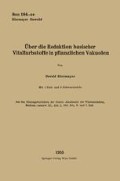Zusammenfassung
Die Vitalf ärbung stellt heute neben Plasmolyse, Mikrochirurgie und Zentrifugierung wohl die wichtigste Methode der modernen Zellphysiologie dar. Mit ihrer Hilfe wurde es möglich, neue Erkenntnisse über die Stoffaufnahme und -speicherung lebender Zellen zu gewinnen.
Die Untersuchung wurde mit Hilfe einer Subvention der Österreichischen Akademie der Wissenschaften durchgeführt, für die der Verfasser seinen ergebensten Dank zum Ausdruck bringen möchte.
Access this chapter
Tax calculation will be finalised at checkout
Purchases are for personal use only
Preview
Unable to display preview. Download preview PDF.
Literaturverzeichnis
Becker, E. R. (1926): Vital staining and reduction of vital stains by Protozoa. Biol. Bull. Vol. 50, 3.
Betz, A. (1953): Untersuchungen über Verhalten und Wirkung der Vitalfarbstoffe Prune pure und Akridinorange sowie Beobachtungen über das Reduktions-Oxydationspotential in Zellen höherer Pflanzen. Planta 41/323–357.
Brooks, S. C. and Brooks, M. M. (1941): The Permeability of living cells. Prot.-Monogr. 19.
Cannan, R. K, Cohen, B., and Clark, W. M. (1926): Studies on oxidation-reduction. X, Pub. Health Rep. U.S.P.H.
Cholnoky, B. v. und H öf1er, K. (1950): Vergleichende Vitalfärbe-versuche an Hochmooralgen. Sitz.-Ber. d. österr. Akad. Wiss., math.-nat. Kl., Abt. 1,159. Bd., Heft 6–10, 143.
Cholnoky, B. v. und Schind1er, H. (1951): Winterlicher Diatomeen- Aspekt des Ramsauer Torfmoores. Yerh. d. zool.-bot. Ges., Bd. 92, 228.
Clark, W. M. (1920): Reduction potential of mixtures of indigo and indigo white, and of mixtures of methylene blue and methylene white. J. Washington Acad. Sc., X, 255.
Clark, W. M. (1923): Studies on oxidation-reduction. Pub. Health Rep. 38, 443–455.
Clark, W. M. and Perkins, M. E. (1932): Studies on Oxidation- Reduction. XVII. Neutral red. J. americ. ehem. Soc. 54 /1, 1228–1248.
Cohen, B., Chambers, R. and Reznikoff, P. (1928): Intercellular oxidation-reduction studies I. J. gen. physiol. 11, 585.
Diskus, A. und Kiermayer, 0. (1954): Die Raphidenzellen von Haemaria discolor bei Vitalfärbung. Prot. 43, 450–454.
Drawert, H. (1940): Zur Frage der Stoffaufnahme durch die lebende pflanzliche Zelle. II. Die Aufnahme basischer Farbstoffe und das Permeabilitätsproblem, Flora 34, 159.
Drawert, H. (1948): Zur Theorie der Aufnahme basischer Stoffe. Zeitschr. f. Naturforschung, Bd. 3 b, 111.
Drawert, H. (1949): Zur Frage der Methylenblauspeicherung in Pflanzenzellen II. Zeitschr. f. Naturforschung, Bd. 4 b, 35.
Drawert, H. (1953): Vitale Fluorchromierung der Mikrosomen mit Janusgrün, Nilblausulfat und Berberinsulfat. Ber. d. d. bot. Ges. 66, 135–151.
Fritz, A. (1951): Veränderungen von Plasmaeigenschaften durch Vital-farbstoffe I. Prune pure. Sitz.-Ber. d. Österr. Akad. Wiss., math.-nat. Kl., Abt. I, 160, 789–828.
Gillespie, L. J. (1920): Reduction potentials of bacterial cultures of waterlogged soils. Soil Sc., IX, 199.
Hirn, I. (1953): Vitalfärbestudien an Desmidiaceen. Flora Bd. 140, 453.
Höfler, K. und Schindler, H. (1951): Vitalfärbung von Algenzellen mit Toluidinblaulösungen gestufter Wasserstoffionenkonzentration. Prot. 40, 137.
Höfler, K. und Schindler, H. (1952): Algengallerten im Vitalfärbeversuch. österr. Bot. Zeitschr. 99, 529.
Höfler, K. und Schindler, H. (1953): Vitalfärbbarkeit verschiedener Closterien. Protopl. 42, 296.
Karrer, P. (1950): Lehrbuch der organischen Chemie. 11. Auflage, Georg Thieme Verlag, Stuttgart.
Kiermayer, O. (1954): Die Vakuolen der Desmidiaceen, ihr Verhalten bei Vitalfärbe-und Zentrifugierungsversuchen. Sitz.-Ber. d. Österr. Akad. Wiss., math.-nat. Kl., Abt. I, 162. Bd., 175–222.
Kiermayer, O. (1955): Ringförmige Zellinhaltskörper bei Spirogyra maxima. Protoplasma 45, 150.
Kinzel, H. (1954 a): pn-Werte alkalischer Phosphatpufferlösungen. Protopl. 43, 441–449.
Kinzel, H. ( 1954 b): Theoretische Betrachtungen zur Ionenspeicherung basischer Vitalfarbstoffe in leeren Zellsäften. Protopl. 44, 52–72.
Krebs, I. (1951): Beiträge zur Kenntnis des Desmidiaceen-Protoplasten. I. Osmotische Werte. II. Piastidenkonsistenz. Sitz.-Ber. d. Österr. Akad. Wiss., math.-nat. KL, Abt. I, 160. Bd., 579.
Küster, E. (1938): Über Vererzung, insbesondere über Vergoldungserscheinungen an Pflanzenzellen. Z. Mikr. 55, 166.
Küster, E. (1942): Vitalfärbung und Vakuolenkontraktion. Zeitschr. f. wiss. Mikr. 58, 245.
Loub, W. (1951): Über die Resistenz verschiedener Algen gegen Vitalfarbstoffe. Sitz.-Ber. d. österr. Akad. Wiss., math.-nat. Kl., Abt. I, 160, 829.
Loub, W. (1953): Zur Algenflora der Lungauer Moore. Sitz.-Ber. d. österr. Akad. Wiss., math.-nat. Kl., Abt. I, 162, 545–569.
Loub, W., UrI, W., Kiermayer, O., Diskus, A. und Hilmbauer, K. (1954): Die Algenzonierung in Mooren des österreichischen Alpengebietes. Sitz.-Ber. österr. Akad. Wiss., math.-nat. KL, Abt. I, 163, 447 bis 494.
Nassanov, D. (1930): Über den Einfluß der Oxydationsprozesse auf die Verteilung von Vitalfarbstoffen in den Zellen. Z. f. Zellforschung 11.
Needham, J. and Needham, D. (1925): The hydrogen-ion concentration and the oxidation-reduction potential’ of the cell-interior; a microinjection study. Proc. Roy. Soc. London B 98, 259.
Needham, J. and Needham, D. (1926): Further micro-injection studies of the oxidation-reduction potential of the cell-interior. Proc. Roy. Soc. London B 99, 383.
Rapkine,L.et Wurmser,R. (1926a): Le potentiel de reduction des cellules vertes. Comp. Rend. Soc. Biol. 94, 1347.
Rapkine, L. et Wurmser, R. ( 1926 b): Sur le potential du reduction des cellules. Comp. Rend. Soc. Biol. Paris 95, 604.
Rapkine, L., Struyk, A. et Wurmser, R. (1929a): Le potential d’oxydo-reduction de quelques colorants vitaux. Comp. Rend. Soc. Biol. Paris 100.
Rapkine, L., Struyk, A. et Wurmser, R. ( 1929 b): Le potential d’oxydo-reduction de quelques colorants vitaux. J. chim. phys. 26.
Rhumb1er, L. (1893): Eine Doppelfärbung zur Unterscheidung lebender Substanzen. Zool. Anz. 16, 47–57.
Ruzicka, VI. (1904): Über tinctorielle Differenzen zwischen lebendem und abgestorbenem Protoplasma. Arch. ges. Phys. 107, 497.
Strugger, S. (1949b): Praktikum der Zell-und Gewebephysiologie der Pflanze. 2. Auflage. Berlin—Göttingen—Heidelberg.
Wanke11, Fr. (1921): Über Reduktion basischer Farbstoffe im lebenden Protoplasma. Ber. d. naturforschenden Ges. Freiburg. Bd. 23, Heft 1.
Weber, F. (1933): Zur Permeabilität der Schließzellen. Prot. 19, 452.
West, W. and G. S. (1904–1912): A Monograph of the British Desmidia-ceae, Vol. I—IV. London.
Author information
Authors and Affiliations
Rights and permissions
Copyright information
© 1955 Springer-Verlag Wien
About this chapter
Cite this chapter
Kiermayer, O. (1955). Über die Reduktion basischer Vitalfarbstoffe in pflanzlichen Vakuolen. In: Über die Reduktion basischer Vitalfarbstoffe in pflanzlichen Vakuolen. Sitzungsberichten der Österr. Akademie der Wissenschaften. Springer, Berlin, Heidelberg. https://doi.org/10.1007/978-3-662-24855-3_1
Download citation
DOI: https://doi.org/10.1007/978-3-662-24855-3_1
Publisher Name: Springer, Berlin, Heidelberg
Print ISBN: 978-3-662-22913-2
Online ISBN: 978-3-662-24855-3
eBook Packages: Springer Book Archive

